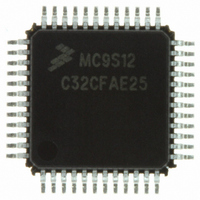MC9S12C32CFAE25 Freescale Semiconductor, MC9S12C32CFAE25 Datasheet - Page 560

MC9S12C32CFAE25
Manufacturer Part Number
MC9S12C32CFAE25
Description
IC MCU 32K FLASH 25MHZ 48-LQFP
Manufacturer
Freescale Semiconductor
Series
HCS12r
Datasheets
1.MC9S12GC16MFUE.pdf
(690 pages)
2.MC9S12C96CFUER.pdf
(26 pages)
3.MC9S12C32CFAE25.pdf
(2 pages)
4.MC9S12C32CPBE25.pdf
(36 pages)
Specifications of MC9S12C32CFAE25
Core Processor
HCS12
Core Size
16-Bit
Speed
25MHz
Connectivity
CAN, EBI/EMI, SCI, SPI
Peripherals
POR, PWM, WDT
Number Of I /o
31
Program Memory Size
32KB (32K x 8)
Program Memory Type
FLASH
Ram Size
2K x 8
Voltage - Supply (vcc/vdd)
2.35 V ~ 5.5 V
Data Converters
A/D 8x10b
Oscillator Type
Internal
Operating Temperature
-40°C ~ 85°C
Package / Case
48-LQFP
Processor Series
S12C
Core
HCS12
Data Bus Width
16 bit
Data Ram Size
2 KB
Interface Type
CAN/SCI/SPI
Maximum Clock Frequency
25 MHz
Number Of Programmable I/os
31
Number Of Timers
8
Maximum Operating Temperature
+ 85 C
Mounting Style
SMD/SMT
3rd Party Development Tools
EWHCS12
Development Tools By Supplier
M68EVB912C32EE
Minimum Operating Temperature
- 40 C
On-chip Adc
8-ch x 10-bit
For Use With
CML12C32SLK - KIT STUDENT LEARNING 16BIT HCS12
Lead Free Status / RoHS Status
Lead free / RoHS Compliant
Eeprom Size
-
Lead Free Status / Rohs Status
Lead free / RoHS Compliant
Available stocks
Company
Part Number
Manufacturer
Quantity
Price
Company:
Part Number:
MC9S12C32CFAE25
Manufacturer:
FREESCAL
Quantity:
240
Company:
Part Number:
MC9S12C32CFAE25
Manufacturer:
Freescale Semiconductor
Quantity:
10 000
- MC9S12GC16MFUE PDF datasheet
- MC9S12C96CFUER PDF datasheet #2
- MC9S12C32CFAE25 PDF datasheet #3
- MC9S12C32CPBE25 PDF datasheet #4
- Current page: 560 of 690
- Download datasheet (4Mb)
Chapter 19 64 Kbyte Flash Module (S12FTS64KV4)
19.4.1.2
The Flash command controller is used to supervise the command write sequence to execute program,
erase, and erase verify algorithms.
Before starting a command write sequence, the ACCERR and PVIOL flags in the FSTAT register must be
clear and the CBEIF flag should be tested to determine the state of the address, data, and command buffers.
If the CBEIF flag is set, indicating the buffers are empty, a new command write sequence can be started.
If the CBEIF flag is clear, indicating the buffers are not available, a new command write sequence will
overwrite the contents of the address, data, and command buffers.
A command write sequence consists of three steps which must be strictly adhered to with writes to the
Flash module not permitted between the steps. However, Flash register and array reads are allowed during
a command write sequence. The basic command write sequence is as follows:
The address written in step 1 will be stored in the FADDR registers and the data will be stored in the
FDATA registers. When the CBEIF flag is cleared in step 3, the CCIF flag is cleared by the Flash command
controller indicating that the command was successfully launched. For all command write sequences, the
CBEIF flag will set after the CCIF flag is cleared indicating that the address, data, and command buffers
are ready for a new command write sequence to begin. A buffered command will wait for the active
operation to be completed before being launched. Once a command is launched, the completion of the
command operation is indicated by the setting of the CCIF flag in the FSTAT register. The CCIF flag will
set upon completion of all active and buffered commands.
560
1. Write to a valid address in the Flash array memory.
2. Write a valid command to the FCMD register.
3. Clear the CBEIF flag in the FSTAT register by writing a 1 to CBEIF to launch the command.
Command Write Sequence
MC9S12C-Family / MC9S12GC-Family
Rev 01.24
Freescale Semiconductor
Related parts for MC9S12C32CFAE25
Image
Part Number
Description
Manufacturer
Datasheet
Request
R
Part Number:
Description:
Manufacturer:
Freescale Semiconductor, Inc
Datasheet:
Part Number:
Description:
Manufacturer:
Freescale Semiconductor, Inc
Datasheet:
Part Number:
Description:
Manufacturer:
Freescale Semiconductor, Inc
Datasheet:
Part Number:
Description:
Manufacturer:
Freescale Semiconductor, Inc
Datasheet:
Part Number:
Description:
Manufacturer:
Freescale Semiconductor, Inc
Datasheet:
Part Number:
Description:
Manufacturer:
Freescale Semiconductor, Inc
Datasheet:
Part Number:
Description:
Manufacturer:
Freescale Semiconductor, Inc
Datasheet:
Part Number:
Description:
Manufacturer:
Freescale Semiconductor, Inc
Datasheet:
Part Number:
Description:
Manufacturer:
Freescale Semiconductor, Inc
Datasheet:
Part Number:
Description:
Manufacturer:
Freescale Semiconductor, Inc
Datasheet:
Part Number:
Description:
Manufacturer:
Freescale Semiconductor, Inc
Datasheet:
Part Number:
Description:
Manufacturer:
Freescale Semiconductor, Inc
Datasheet:
Part Number:
Description:
Manufacturer:
Freescale Semiconductor, Inc
Datasheet:
Part Number:
Description:
Manufacturer:
Freescale Semiconductor, Inc
Datasheet:
Part Number:
Description:
Manufacturer:
Freescale Semiconductor, Inc
Datasheet:











